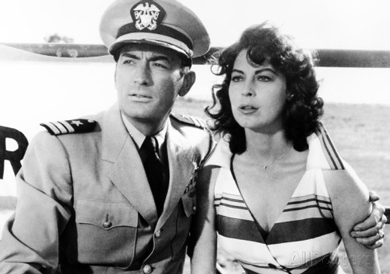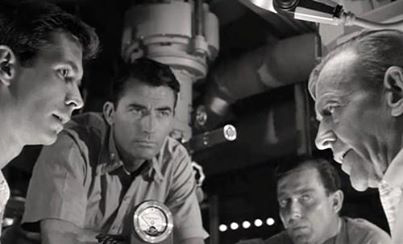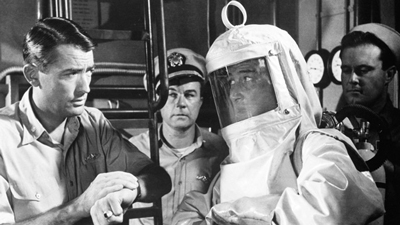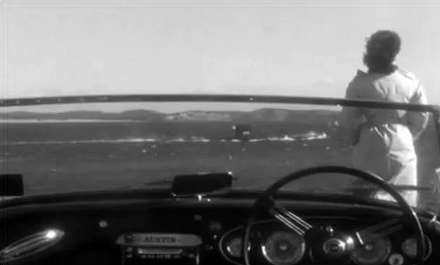Reviewed by Glenn Erickson
Let us go back, if we may, to the information-challenged 1950s. Nuclear war was a buzzword but not a subject that the average American knew very much about. Despite (or because of) official public service films, the factual nature of radioactivity wasn't widely disseminated. Film culture did its part to confuse the issue, by either downplaying the effects of radiation on humans or wildly exaggerating them. Even the subversive Kiss Me Deadly with its fissionable 'great whatsis' used classical allusions to keep real science at a distance. That same year, the world's first atomic submarine was launched, the USS Nautilus. Nuclear power enjoyed excellent public relations.
Australian Nevil Shute's enormously influential 1957 novel On the Beach chronicles the end of the world from the point of view of a number of atom war survivors in Melbourne, Australia. The date is January 1964. The exact cause of the nuclear exchange is not known, but the entire Northern Hemisphere has been wiped out. Seasonal winds will soon blow the radioactive fallout to the Southern half of the planet. In just a few months, most life on earth will be extinct. Shute's book became a controversial best seller. Hawkish spokesmen, including military experts, declared that no nuclear exchange could end with the extermination of humanity. But leading scientists affirmed the basic premise. Some went so far as to say that the issue was not "if," but "when."

Stanley Kramer's expensive film adaptation of On the Beach creates an odd dislocation that annoyed many critics. Kramer claimed that his anti-nuke film had the noble aim of saving the world, and its advertising tagline read: "If You See Just One Film This Year You Must See On The Beach". He enlisted the endorsement of the famed scientist Linus Pauling, providing publicity both for the film and for Pauling's campaign to halt aboveground nuclear testing. For a simultaneous global premiere, each of the film's stars was dispatched to a different world capitol. If one wants to give On the Beach credit for turning public opinion and helping President Kennedy push through 1963's Limited Test Ban Treaty, Kramer's film was an enormous success.
Opposing this noble quest are Kramer's highly developed commercial instincts. He retains the book's fatalistic ending but recasts Shute's 'ordinary people' with glamorous movie stars -- Ava Gardner and Gregory Peck generated a lot of romantic chemistry. Whereas the characters in the novel reacted to doomsday "not with a bang but a whimper", John Paxton's script gives each victim a grandstanding soliloquy, a morbid crisis moment, or both. Australian naval officer Peter Holmes (Anthony Perkins) and his wife Mary (Donna Anderson) must deal with the necessity of committing suicide along with their baby daughter. Nuclear scientist Julian Osborne (Fred Astaire, in his first straight acting role) grapples with professional guilt for helping develop the bomb. To combat his feeling of impotence, Julian rejects the advances of beautiful Moira Davidson (Ava Gardner) and tries to commit suicide with other fanatics in a big car race. The desperate Moira begs for comfort from American submarine commander Dwight Towers (Gregory Peck), only to discover that Towers is in denial over the demise of his family back home. A straight-arrow Navy man, he follows the book to the bitter finish. Moira must reconcile herself to a lonely death.

Kramer's film did acceptable business despite reviews that emphasized its depressing aspects. Daily Variety: "The spectator is left with the sick feeling that he's had a preview of Armageddon, in which all contestants lost." Despite its melodramatic crises the show is for the most part sharply directed and has many powerful scenes. With gasoline mostly unavailable, horse drawn buggies and bicycles crowd the roads. The submarine Sawfish makes an eerie entrance to the now-dead San Francisco Bay. A homesick sailor (John Meillon) jumps ship at Market Street, preferring to die in the dead city where he was born. 1 The film's most suspenseful set piece occurs in San Diego, where a lone crewmember dons a radiation suit to locate the source of a mysterious telegraph signal. Ernest Gold's previously gentle score suddenly becomes thunderingly bold during the investigation of the dead Californian cities.
It's time for a re-evaluation of On the Beach, as its reputation has slipped along with that of its producer-director. Stanley Kramer courted controversy to promote his talky debate movies, that 'resolved' one social issue after another: medical ethics (Not as a Stranger), race prejudice (The Defiant Ones, Guess Who's Coming to Dinner?), evolution vs. creationism (Inherit the Wind), German war guilt (Judgment at Nuremberg). Italian cinematographer Giuseppe Rotunno lends On the Beach stylistic refinements not seen in other Kramer pictures. The direction is economical and graphically clean, and the fully storyboarded shots work much better than earlier Kramer efforts, such as The Pride and the Passion. Nobody forgets the long lines of citizens picking up government-dispensed death pills. The Gran Prix race, with sports cars crashing in an insane frenzy, offers a taste of the violent madness of post-apocalyptic movies to come. Was On the Beach an inspiration for Mad Max?

Although Australians complained about Anthony Perkins' accent, the domestic scenes between Perkins and Anderson are probably Kramer's best-directed material. He progressively tilts the camera for some scenes to create an insecure feeling. Dwight and Moira's impassioned embraces carry real power, even if Kramer does run away with himself at one point, imitating the 360-degree kissing scenes from Hitchcock's Vertigo. Their last kiss is a knockout. Backlit in front of bright water, Gardner and Peck's faces glint and sparkle in a huge close-up. The filtered backlight 'dissolves' their features, working as a visual correlative to the lethal radioactivity eating into their bodies. The final scene at the windy entrance to Melbourne harbor is a perfect expression of doomed isolation: the camera finds Moira Davidson standing by her Austin-Healy, watching the Sawfish sail away. Kramer was lucky not to have to use miniatures, as the U.S. military refused to cooperate with the production. Australian ships took their place.
On the Beach is perhaps Stanley Kramer's best-directed film. It did influence public thinking, altering the perception that nuclear bombs are practical weapons, and helping to kick-start the anti-nuke debate of the 1960s. Naysayers call it a protracted soap opera, but it's an underplayed and fairly daring picture that faithfully reproduces Nevil Shute's novel.

In the end we're left with many haunting and poetic images. The desolate oil refinery now resonates with the imagery of science fiction movies like Quatermass 2. A lone man is dwarfed by the huge chemical installation that expresses his vulnerability to a frightening technological future. America has been converted into a sterile land suited only for creatures that can live in highly radioactive conditions. The fatalistic phrase, "When the time comes" keeps cropping up, looking forward to the perverse survival scheme of Joseph Losey's These Are the Damned. The authority figure in Losey's film flatly asserts that nuclear war is inevitable. On the Beach is an honest warning against nuclear proliferation. 4
The KL Studio Classics Blu-ray of On the Beach is a reasonably good transfer of this beautifully-filmed show, that displays the masterful lighting of Italian camera genius Giuseppe Rotunno (The Adventures of Baron Munchausen). The film element transferred does have a number of issues, including more wear than usual at reel changes, and more dirt than is normal. Also, it looks as if the film's negative were poorly spliced (or re-spliced), for at many cut points the image jumps slightly, and traces of what looks like film cement mar frames before and after. The movie is still visually impressive, but what's needed is a major digital restoration.
KLSC has released the movie separately on both Blu-ray and DVD. I've checked my Blu-ray copy on two separate players (Sony and Toshiba) and the audio sync looks soft throughout. Individual scenes appear to play back with even more of a sync problem. I personally would still buy the disc -- I have several favorites with worse flaws that I've watched multiple times -- but if this flaw is on all copies Kino Lorber might want to re-press. I'd not advise prospective buyers to cancel out on my say-so -- check other reviewers first.

That issue aside, the track sounds great. Composer Ernest Gold provides chilling cues for Captain Towers' hearse-like submarine. The most common complaint against the film today is that Gold's score grossly overuses the traditional tune Waltzing Matilda. It wasn't as well known abroad then as it is now, but I must admit that it wears thin, especially over repeated viewings. Don't ask how many times I've seen this picture, as I'm ready to look at it again, right now. In selected scenes the song is still very effective.
The disc includes a terrific original trailer that touts the film's multiple simultaneous premieres in international capitals around the world. The enormous neon marquee in New York is very imposing. The trailer conveys the high-toned, urgent feeling that Stanley Kramer wanted.
On a scale of Excellent, Good, Fair, and Poor,
On the Beach Blu-ray rates:
Movie: Excellent
Video: Good + / -
Sound: Not Good; major sync issues
Supplements:
Deaf and Hearing Impaired Friendly?
YES; Subtitles: English
Packaging: Keep case
Reviewed: August 10, 2014
Footnotes:
1. In the San Francisco sequence, the Sawfish sits off the Embarcadero as the sailors take turns looking at the city streets through the periscope. The image drifts slowly up and down as the sub rocks with the tide. The movement matches perfectly across cuts. This was done by 'rocking' the image in an optical printer, moving the 1:66 area up and down on the cut negative. On old 16mm prints the top and bottom frame lines can be seen drifting in and out, while the center 1:66 area remains undisturbed. For its year, this is a very clever optical trick.
Return

2. A worthy link -- A contrasting, well written critical analysis of this Blu-ray can be found in Stuart Galbraith IV's On the Beach Review.
Return
3. Personal remarks:
I first saw On the Beach broadcast from Los Angeles sometime in the mid-1960s. What frightened me most was that I couldn't find any adults who wanted to talk about it -- the subject matter just wasn't talked about in my family, in the same way we didn't talk about funerals. When I talked about nuclear war with my friends, we were careful not to be overheard -- as if we were discussing Playboy magazine. I have to think that it was more than 'protecting the kids', and perhaps a symptom of my parents' own unease. An undertaker (I kid you not) at the end of the block installed a bomb shelter in his back yard during the Cuban Missile Crisis: that was mentioned once and dropped. When Dr. Strangelove reached TV in the later '60s, I didn't get any opinions yea or nay about it either.
Anybody else from that era grow up in a similar "selectively self-censored" household?
Response from Tom Giegel, 8.26.2014:
Hi, Glenn. Your recently posted reviews of films with nuclear war themes, On The Beach and Testament reminded me of an even earlier filmed presentation on the subject. Flash of Darkness is an episode of the 1954 "reality"-based medical TV series, Medic, starring Richard Boone. The episode aired on February 24,1955. In it Richard Boone plays a physician heading a disaster response medical team. A nuclear bomb has struck Los Angeles and his team has established itself in an area near the blast zone. They are to treat, as best as they can, injured survivors of the detonated nuclear weapon, of which there are many. During this episode, a radio broadcast notes that several other American cities have been hit; retaliation against the aggressor enemy has been swift and heavy. In other words a full-scale nuclear war has erupted.
What makes this episode so interesting is context in which the entire event is placed. Although terrible, the detonation of a nuclear bomb is taken to be no more serious than a very strong natural disaster, such as a hurricane, a series of tornados or a massive earthquake. The event is to be more or less shaken off with recovery soon to begin shortly thereafter. Nuclear fallout is hardly mentioned. This nuclear "event" thus isn't the civilization-ending threat posed in the later films but something from which people will eventually recover. This attitude is quite odd really when you hear the names of the other large American cities similarly hit. In reality of course, even in a brief nuclear exchange the mere economic consequences on the nation's infrastructure would be absolutely catastrophic, not to mention the toll of human death due to radiation in the following months. The true consequences of such a devastating event would be more in sync with that depicted in the terrifying telepic, The Day After.
Flash of Darkness may be perhaps the first filmed presentation on the effects of a nuclear disaster. For a nationally aired TV show, it is thus remarkable. The 26-minute episode is available for free viewing at YouTube. You may want to check it out.
Hope you are enjoying, immensely, your vacation! -- Tom Giegel
Response from Edward Sullivan, 8.27.2014:
Hi Glenn: The most right wing of my maternal uncles expressed rich, rolling, ribald derision of the 'Pinko Pansie' Anti-nuke protestors in the 1960s, declaring them brain-dead alarmists.
When his family moved out of their home to richer digs in the late '70s, my cousin asked me to help him retrieve the canned jellies and jams from 'the cellar'. I was confused when he headed out the back door and into the fenced backyard...
... where he proceeded to open up a camouflaged stairway down to an A-bomb survival bunker. 'Turned out the uncle had a public stance (as the owner/salesman of a metal works business) and a private one -- and had sworn the family to secrecy about the latter... Ed Sullivan
Response from Michael Evans, 8.28.2014:
Hi Glenn, I enjoyed your review of this one.
Just had to enlighten you as to the location for the final scene with Ava Gardner. There is no such place as 'Melbourne Harbour' (although there is certainly a 'Sydney Harbour'). That scene was shot at the historical Victorian town of Queenscliff at the back beach. Queenscliff is at the tip of the heads to Port Philip Bay. All ships have to pass through these heads to get to the docks of the city of Melbourne, which are near Williamstown (named after King William). Queenscliff, the town my British ancestors settled in on my mother's side, was named after Queen Victoria. We used to have a holiday home down there (once my great great aunt's) and my mother was there the day they filmed Ava's big scene. I recall she said that she met Gregory Peck (who may have been there for moral support). They filmed the beach scenes with Tony Perkins (whose accent was truly terrible) at Frankston, a bayside suburb about an hour from the city by car.
The last time I saw this was in a theatre about twenty years ago. The audience laughed at the over-use of Waltzing Matilda, notably in the storm sequence in which Ava & Greg reach out for each other. Otherwise, the movie held up and went down well. Ava was (mis)quoted as saying "Melbourne is the ideal place to make a movie about the end of the world" and apparently flew frequently to the casinos in Sydney. Gambling was not legalized here until the late '70s or '80s. Melbournians did not take her to their bosom.....
I also enjoyed your reviews of Arch of Triumph (which I have on SD from Germany but have yet to view) and The Unforgiven, which was released on Blu Ray here a while ago. All my best to you, Mike
Response from Ian Whittle, 9.02.2014:
Hello Glenn: I read your reviews of On The Beach and Testament with great interest -- both have been on my wish list for ages. What a shame the former is out of sync. Looks like I'll have to get the old retro DVD.
My favourite nuclear holocaust drama is a UK TV special called Threads from 1984. It's on UK DVD (no extras and poor quality) and YouTube, but I thought this would be especially interesting - a round-table Threads discussion on Newsnight (our version of 60 Minutes) following its broadcast. Scary times...
Twilight Time is releasing When The Wind Blows later this year. That's another favourite of mine, though I prefer the book as it's more grim and doesn't have pleasant pop songs undermining the depressing moments!
Take care, and remember... -- Ian.
4. Research notes on On the Beach and author Nevil Shute:
Taken from an On the Beach BBC radio show produced by Libby Purves, Tuesday 24 November 2009.
Author Shute and Stanley Kramer clashed often. Kramer stated that it would be ""the most important film ever made."
Shute had gone to Australia in 1950 looking for something new. Biographer Julian Smith says that Shute wondered if Australia would survive a nuclear war because of its location. But the research said no.
The key to the 1957 book for Shute was, "How do they react?" The book sold four million copies. Kramer made issue films, glamorous pictures with fat messages. He was an unsubtle director. UA was opposed to project at first. The Eisenhower administration didn't like it either, and didn't cooperate. Kramer got his submarine from the Australian Navy. Melbourne liked the shoot. The film was faithful to the novel. The doomed continue with ordinary behavior, making no fuss. Everyone accepts their fate.
Kramer said that UA insisted on the big stars. Gregory Peck and Gardner thought the theme important and loved the script. At age 60, Fred Astaire liked getting away from singing and dancing. Kramer said Astaire was insecure, but liked the film's impact. Ralph Richardson and Alec Guinness were considered. Donna Anderson is still alive. She thought her character was frustrating and in ridiculous denial.
Author Shute found film painful. He didn't like the casting of Americans. Complained that the movie avoids showing killing of child, but played up the violent car crashes. Censorship prohibited shots of anyone taking suicide pills or actually dying on screen. One scene of Astaire finding a suicide's corpse in the street was cut out. Shute's daughter said the author was apoplectic over the fact that Kramer had Commander Towers and Moira consummate their romance -- he hated that change, hated the adultery angle. He died a month after the film was released.
There were major premieres all over, but the Melbourne opening left people "reeling". The film was criticized for scare mongering and bad science. According to some scientists, the idea that trade winds would blanket the earth in radioactivity has some merit. But naysayers think that the radiation would diminish after time and not spread over a wide distance. The "radioactive cloud blanketing the Earth" theory is just a theory.
The Eisenhower Administration said that the film is false, defeatist, subversive. Although branded as propaganda, the movie helped the anti-nuke, Ban the Bomb movement.
Shute hated the Big Fat Message in the ending sign that reads, "THERE IS STILL TIME BROTHER". Shute preferred his fatalism simpler, not propagandistic.
Film critic Derek Malcolm said that On the Beach is beautiful, and successful in its influence. Scientist Linus Pauling said it saved the world.
Return

Text © Copyright 2014 Glenn Erickson
See more exclusive reviews on the Savant Main Page.
Reviews on the Savant main site have additional credits information and are often updated and annotated with reader input and graphics.
T'was Ever Thus.
Return to Top of Page
|




